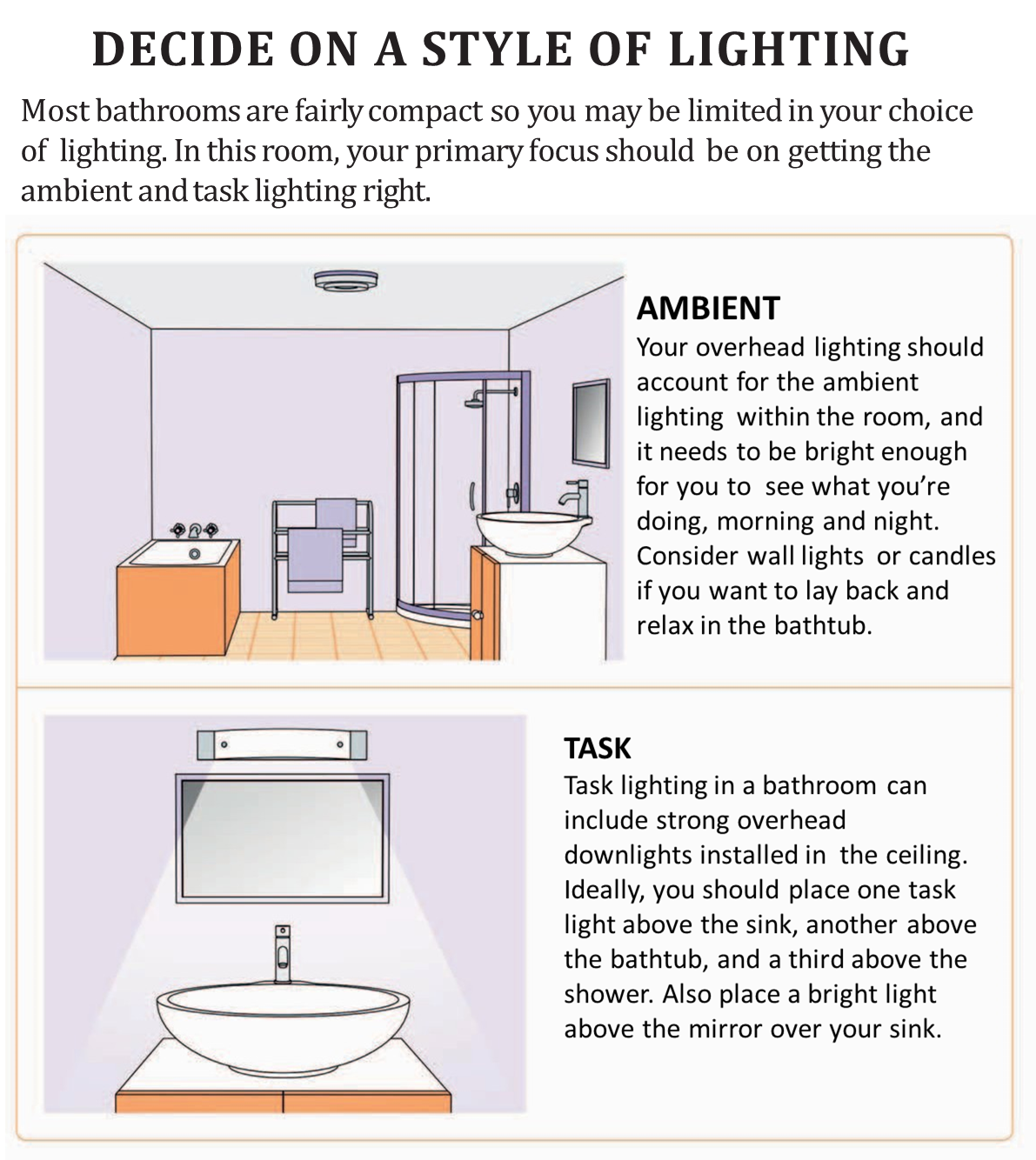CHOOSE BATHROOM LIGHTING
Bathrooms need to be well-lit
so that they feel bright and welcoming and you can see what you’re doing if
you’re shaving or applying makeup. However, bathroom lights also need to cope
with the amount of moisture generated, particularly if you have a shower in the
room, so make sure you choose suitable fixtures.
DECIDE
ON A STYLE OF LIGHTING
Most bathrooms are fairly
compact so you may be limited in your choice of lighting. In this room, your
primary focus should be on getting the ambient and task lighting right.
AMBIENT
Your overhead lighting should account
for the ambient lighting within the room,
and it needs to be bright enough for you to see what you’re doing, morning and night. Consider wall lights or candles if you want to lay back and relax in
the bathtub.
TASK
Task lighting in a bathroom can
include strong overhead downlights installed in the ceiling. Ideally, you should place one task
light above the sink, another above the bathtub,
and a third above the shower. Also, place a bright light above the mirror over your
sink.
CHOOSE YOUR LIGHT FIXTURES
There’s nothing worse than a poorly
lit bathroom—it makes the room feel cold, unwelcoming, and smaller than it really
is. So, ensure you get a good combination
of lighting types within the room, space and budget permitting.
CEILING
LIGHTS
CEILING LIGHT
A central ceiling light provided it is used in combination
with other types of lighting, will provide
good levels of ambient lighting in a bathroom. For safety reasons, the light itself must be enclosed or flush.
A prominent fixture is not the best choice
if your bathroom has a low ceiling.
SPOTLIGHTS
Spotlights are good for providing both task and accent lighting
in a bathroom; their adjustable heads mean
you can direct the light exactly where you need it. Choose from individual heads, bars or plates with two
to four heads that can be adjusted independently
of each other.
RECESSED DOWNLIGHTS
Recessed downlights offer high levels of practical lighting
in a bathroom, and their unobtrusive design
makes them perfect for a small or low-ceilinged bathroom. If you are using these lights over a
shower or bathtub, you will need to purchase
sealed downlights.
RECESSED UPLIGHTS
Highlight your bathroom walls using recessed floor up-lighters.
Install them near to the wall around the
edges of the room to create subtle shafts of light that will illuminate your chosen wallcovering. A dimmer switch
will also allow you to vary the height the
light travels and create different moods in the room.
WALL-MOUNTED
LIGHTS
WALL SCONCES
Used in addition to a central ceiling light or downlights, wall sconces can provide a soft atmospheric light and also add interest to your room’s decorating scheme. Install them in alcoves, on each side of a mirror, or even above
a bathtub.
OVER MIRROR LIGHT
These lights provide bright task
lighting. The design is often long and slim
with an electrical receptacle in one end. They typically work independently from another lighting in the bathroom.
Some bathroom mirrors have lighting built
into them that works in the same way.
SAFETY OPTIONS
When it comes to bathroom lighting,
it’s safety first. You need to make sure
that your light fixtures are appropriate, safe to use, and correctly positioned. Electrical equipment used
in bathrooms must be protected against the
inevitable condensation, humidity, and sprays of water that come with the territory.
While it is always best to have
a certified electrician do the electrical
installation, it is still important to understand some of the safety options available for lighting fixtures
used in bathrooms.
1. A good rule of thumb to use when selecting lighting for wet
areas such as the bathroom is to check the UL (Underwriter’s Laboratory) listing. The UL establishes
testing criteria for lighting fixtures
and rates fixtures based on how well-suited they are for areas where there is a risk they will be
exposed to moisture. Ratings are: Wet, Damp, and Dry.
2. Wet-rated fixtures should be
used in locations with the risk of contact with direct flowing water or moisture, for instance, near showers and
bathtubs.
3. Damp-rated fixtures are suitable
for areas where there is a risk of exposure to condensation. This can include downlights,
surface-mounted ceiling lights, and wall sconces that will be positioned near steamy showers, bathtubs, or saunas.
4. Dry-rated fixtures should
only be used in areas where there will be a low chance of exposure to moisture
vapour. An example of such an area would be a large, well-ventilated bathroom.
5. In addition to the UL rating,
other considerations may apply when you are
deciding where to locate electrical items in the bathroom.
6. If you are including a
steam shower or sauna in your renovated bathroom you should be aware that special
“vapour-proof” fixtures are available. The
fixtures are sealed with gaskets to prevent steam from migrating into the ceiling and causing damage.










No comments:
Post a Comment